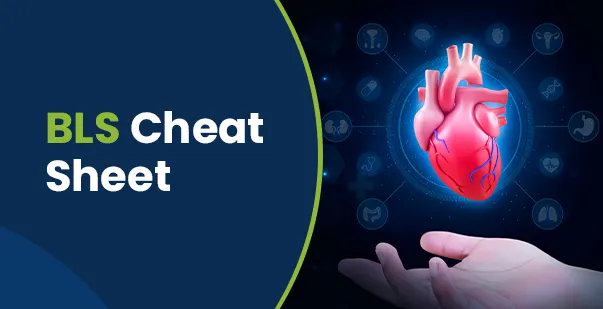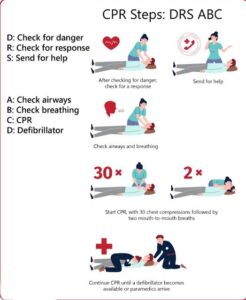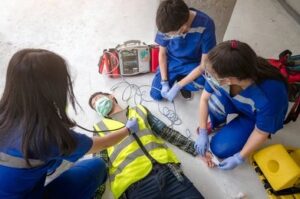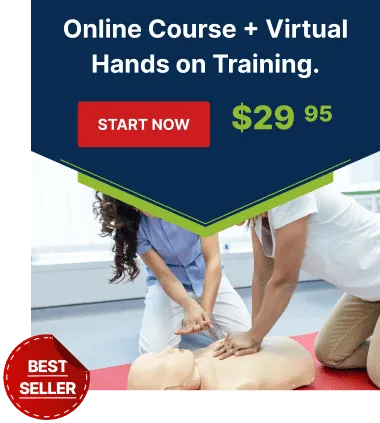Basic life support (BLS) is a set of essential skills used to help someone during emergencies like cardiac arrest and choking. However, with guidelines always changing, remembering every detail can be difficult. A BLS cheat sheet provides a step-by-step guide for healthcare workers and responders. It will boost your confidence in responding to high-stress situations. By the end of this blog, you will understand the important BLS steps and how to apply them in emergencies.
Master BLS Now
Get BLS certified with confidence
What Is A BLS Cheat Sheet?
A BLS cheat sheet is a quick reference guide that outlines essential steps and techniques for responding to life-threatening emergencies. It summarizes procedures like CPR, rescue breathing, the use of an Automated External Defibrillator (AED), and choking relief. The cheat sheet will help reinforce important concepts for BLS certification exams and provide special instructions personalized for every age group. Let us discuss the different procedures in a BLS cheat sheet.
Components of CPR (C – A – B)
The most important aspect of the BLS skills check-off cheat sheet is the components of CPR. The components of CPR are C – A – B, which stands for Compressions, Airway, and Breathing.
Chest compressions are the most important part of CPR because they help pump blood to the brain and vital organs when the heart has stopped. It will thus delay permanent damage and increase the chances of survival until professional help arrives.
The airway should also remain open so that the person receives oxygen. If it is blocked, air cannot reach the lungs. By tilting the head back and lifting the chin, you can create a clear path for air to enter and support proper breathing during rescue efforts.
Rescue breaths supply oxygen to the lungs when normal breathing has stopped. This helps maintain oxygen levels in the blood, which is critical for keeping the brain and other organs alive. Breathing support ensures the body’s cells stay functional during a cardiac emergency.
Read More: What Does CAB Stand for in CPR?
BLS Algorithm
The BLS cheat sheet outlines actions like ensuring scene safety, assessing the patient, and providing rescue breathing for adults, children, and infants. It will help you revise quickly for your exam. The steps to follow in case of an emergency are:
-
Check for Scene Safety
Before helping the patient, both rescuers must ensure the environment is safe. Look around for dangers, such as moving traffic, fire, exposed wires, or sharp objects. Do not approach if the area is unsafe. Your safety is a priority, so you can help effectively without becoming injured.
-
Assess the Patient
The first rescuer should approach the patient and check for a response. Gently tap the patient’s shoulders and say, “Are you okay?” loudly. Look for signs of life, such as breathing or chest movement. If the patient doesn’t respond and shows no signs of breathing, begin emergency procedures immediately.
-
Administer Rescue Breathing
The steps to administer rescue breaths differ for adults, children, and infants. For adults, children, and infants, each breath should last approximately one second. During this time, air should enter the lungs without causing complications like stomach inflation. Care must be taken to avoid blowing too forcefully, as excessive air can harm the victim. Chest rise should be noted to confirm proper ventilation.
| Aspect | Adult | Child | Infant |
| Breathing Rate | One breath every 5–6 seconds (10–12 breaths per minute) | One breath every 3–5 seconds (12–20 breaths per minute) | One breath every 3–5 seconds (12–20 breaths per minute) |
| Breath Strength | It should be strong enough to raise the chest without excessive force, visibly. | It should be gentle but sufficient to make the chest rise. | It should be very gentle to avoid lung injury, just enough to raise the chest. |
| Seal Position | You should cover your mouth only. | You should cover your mouth only. | It should cover both the mouth and nose. |
-
Administer CPR
The most important part of any BLS review sheet is the steps to perform CPR. CPR needs to be performed correctly to save the life of the victim. In all cases, CPR aims to maintain blood flow and oxygenation to vital organs by using a cycle of chest compressions and rescue breaths. The recommended compression rate is consistent at 100–120 compressions per minute, with full chest recoil between compressions. Each breath should last about 1 second and visibly raise the chest. The compression-to-breath ratio is 30:2 for a single rescuer in all scenarios.
| Aspect | Adult | Child | Infant |
| Compression Depth | It should be around 2 inches(5cm). | It should be around 2 inches(5cm). | It should be around 1.5 inches(4cm) or one-third of the chest depth. |
| Hand/Finger Position | Both hands need to be used, with one on top of the other in the center of the chest. | One or two hands, depending on the child’s size, in the center of the chest | Use only two fingers or encircle the chest with both thumbs. |
| Compression-to-Breath Ratio | 30:2 for a single rescuer | 30:2 for single rescuer, 15:2 for two rescuers | 30:2 for a single rescuer, 15:2 for a two-rescuer |
| Lung Sensitivity | It is less sensitive compared to children and infants. | They have smaller lungs, so they require gentle breaths. | Very delicate lungs, and thus they require the softest breaths. |
Using an Automated External Defibrillator (AED)
An Automated External Defibrillator (AED) is a life-saving device that checks the heart’s rhythm and delivers a shock if needed. The use of an AED within the first 3–5 minutes of sudden cardiac arrest can increase survival rates by up to 70%. AEDs are simple to use and provide step-by-step instructions to help responders during emergencies. The steps to use an AED according to the AHA BLS cheat sheet are:
- Locate the AED and turn it on immediately. Most AEDs will have a power button or will turn on automatically when opened. Follow the voice prompts and instructions provided by the device.
- Place the AED pads on the patient’s chest, as shown in the diagrams. For adults, one pad goes on the upper right chest, and the other goes on the lower left side of the chest. If pediatric pads are available, use them for children under 8 years of age or infants.
- Ensure no one is touching the patient while the AED analyzes their heart rhythm. The device will tell you if a shock is needed.
- If the AED advises a shock, ensure everyone is clear of the patient. Shout, “Clear!” before pressing the shock button.
- After delivering the shock, start chest compressions immediately. Continue CPR until the AED reanalyzes or professional help arrives.
Choking Relief
The BLS answer sheet clearly outlines the steps to handle choking emergencies. It includes techniques such as the Heimlich maneuver, abdominal thrusts, and back blows, which help clear the airway and restore breathing.
-
Heimlich Maneuver Steps
The Heimlich maneuver is used to help someone who is choking. Stand behind the person and wrap your arms around their waist. With one hand, make a fist just above the belly button. Grab your fist with the other hand and press inward and upward quickly. Repeat these abdominal thrusts until the object is expelled or the person can breathe or cough again.
-
Abdominal Thrust Steps
Abdominal thrusts are the main part of choking relief. First, ensure the person is actually choking and cannot cough or speak. Stand behind them and place your arms around their waist. Make a fist and position it just above their belly button but below the ribcage. Grab your fist with your other hand and press inward and upward with a quick motion, using enough force to dislodge the object. Repeat thrusts until the airway is clear. If the person becomes unconscious, begin CPR and check for the object in the mouth before giving breaths.
-
Back Blows and Chest Thrust Steps
Back blows and chest thrusts are especially useful for infants and smaller children. For an infant, hold them face down along your forearm, with their head supported and lower than their chest. Use the heel of your hand to deliver five firm back blows between the shoulder blades. If the object isn’t expelled, turn the infant face up and give five chest thrusts by pressing two fingers on the breastbone just below the nipple line. For children, alternate back blows and chest thrusts as needed. Continue until the airway is cleared or emergency help arrives.
Mastering BLS for Effective Response
The BLS cheat sheet is an essential tool for healthcare workers and responders, providing a quick guide to save lives during emergencies. It simplifies steps like performing CPR, using an AED, and relieving choking. By following the AHA BLS cheat sheet, you can stay prepared to act confidently and quickly, whether you’re dealing with adults, children, or infants. Stay updated with your training, practice regularly, and always prioritize safety during emergencies. To gain hands-on experience and improve your life-saving skills, consider taking a BLS course. Sign up today to be better prepared for any emergency.
References
https://www.cprtrainingaustin.com/your-ultimate-bls-cheat-sheet-for-2023/
https://emedcert.com/blog/ultimate-bls-cheatsheet#common-abbreviations-to-know
